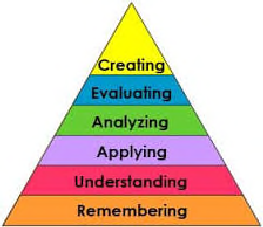
|
Creating: compose, construct, design, develop, formulate, manage, organize, plan, prepare, propose, write. |
|
Evaluating: appraise, argue, assess, contrast, defend estimate, judge, predict, value. |
|
Analyzing: categorize, compare, contrast, criticize, distinguish, examine, experiment, question, test. |
|
Applying: choose, demonstrate, dramatize, employ, illustrate, interpret, practise, sketch, solve, use, write. |
|
Understanding: classify, describe, discuss, explain, express, locate, report, review, select, translate. |
|
Remembering: arrange, define, label, list, memorize, name, order, relate, recall, repeat, reproduce, state. |
|
Creating: How would you create a new story to convey some of these ideas? |
|
|
|
|
|
|
Evaluating: What choices would you have made if you were in the story? |
|
|
|
|
|
|
Analyzing: How is this story related to your life? |
|
|
|
||
|
Applying: What questions would you ask in an interview with the main character? |
|
|
|||
|
Understanding: What is the main idea of the story? |
|
||||
|
Remembering: Who was the main character? |
|||||





